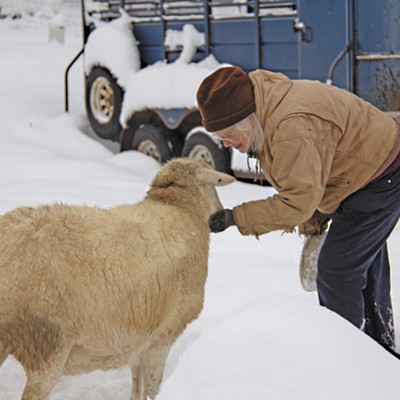The rumbling, dirt-splotched Ford F-350 is surrounded on all sides by hulking, hairy beasts. Victor Piengkham, 25, is behind the wheel. Wearing a sleeveless white undershirt and a long black ponytail, he bounces the Ford across the cratered field. Lyle Witford, 23, sits with the hay in the back. As the beasts shamble aside to let the truck pass, they’re relatively calm at first. One thrashes its head back and forth in the dirt, a way of cooling off in the heat. But then, a chorus of deep grumbling begins to rise up from the herd.
“I think we might need to move,” says J.B. Finley, a 25-year-old with a bear claw his family’s symbol tattooed on each arm. One thing he knows: You don’t mess with a buffalo in heat.
For Finley and the others, it’s another day at the office, another day herding the 140 or so animals that roam 600 acres of pasture on the Kalispel reservation. Call them bison all you want, but here on the rez, they’re buffalo. The tribe sells the meat, the hides, the skulls and the animals themselves.
“But that’s not why we have them,” Piengkham says.
Instead, it’s an extra source of food and employment for young tribal members like Finley.
And it’s tough employment a far cry from the air-conditioned, cubicle-bound, paper-pushing jobs held by others of Piengkham’s age.
The sun is hot. Sometimes the days are long, stretching 14 hours. They feed the buffalo, they repair the fences, they harvest fields of hay though all three suffer from hay fever. They round up the buffalo in October to give them vaccinations. And they stand ready to shoot any cougars or coyotes that threaten the herd.
There are benefits, of course. Five times a year, the buffalo ranch workers kill a few animals and send them to a butcher in Diamond Lake, Wash., where the animals become burgers, steak and jerky. “We usually just go door-to-door and give [tribal members] burgers and steaks,” Piengkham says. The jerky disappears quickly, he notes everyone loves buffalo jerky.
Misfortune, meanwhile, makes the job harder. Normally, there would be a massive buffalo roast this week.
But high snows flooded the pasture earlier this year. The herd found higher ground, but the waters surged over the sandbags and into the buffalo ranch’s garage, seeping into the walls, killing appliances and ruining 400 tons of hay about $40,000 worth. As a result, this year’s powwow, which would have taken place last week, was canceled.
There's also the danger. These beasts are not easily controlled. “They’re not tame animals,” Piengkham says.
Right now, after all, it’s the height of mating season, which lasts from June to September. A dangerous job becomes even more dangerous, as buffalo get protective, aggressive, and fight amongst each other. They charge fences. Among the herd, hierarchy can be cruel and ironclad. Two-year-old buffalo can starve to death, not because there’s not enough food but because they’re too far back in the pecking order.
The F-350 truck has a battle-wound, a massive dent on the driver’s side and it’s not from a car crash. It was from an incident last year, also when the buffalo were in heat.
Finley was there. One beast rammed the side of another, pushing it right toward the truck 70 feet away. The diesel truck takes a second to start up. But the buffalo, Finley says, slammed up against the truck in a second and a half. For five long seconds or was it 10? the truck lifted up on its two side wheels. “If my life ever flashes before my eyes,” Finley says, “I’m going to see that.”
Finley points to a particularly large and surly bison.
“He gored a guy a couple years ago. Flew him like 15, 20 feet in the air,” Finley says. “Ripped the muscle from the bone in his calf.”
He survived, though now everyone calls the guy “Buffalo Tim.”
In one sense, this job is generational. Finley’s father ran the ranch, and Whitford’s father ran it before that. They grew up on buffalo meat.
“For a while it seemed like beef and pork were a delicacy,” Finley says.
Family remains, as always, important. Piengkham has a tattoo of a clenched fist the American Indian logo and a phrase in his father’s language, Lao, that means something along the lines of “warrior.’” “We were pretty wild when we were younger,” Piengkham says.
Some Kalispel could likely speak at length about the importance of owning buffalo herds for a tribe that, 200 years ago, hunted roaming herds on the plains. But while all three have tattoos, T-shirts or hats speaking to their pride in their tribe or nationality, they don’t see the buffalo herd with any symbolism. It’s a job, nothing more.
“We’re just trying to live our lives, really,” Piengkham says. “We aren’t trying to be role models for the tribe or anything.”
Fifteen dollars an hour, 40 hours or more a week.
And for the foreseeable future, it’s a career.
“We don’t have to be indoors,” Piengkham says. “It’s good hard work.”





















